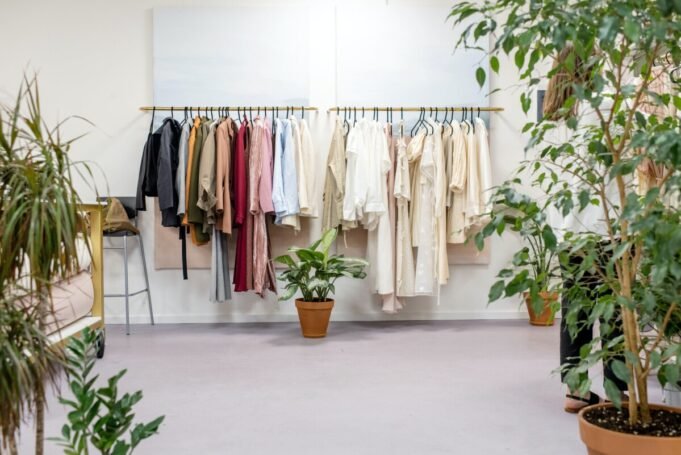Upcycling and repurposing clothing is a creative, eco-friendly way to refresh your wardrobe and reduce textile waste. By giving old, worn out, or unused clothes new life, you can craft unique fashions while embracing sustainable fashion practices. This comprehensive guide will teach you everything you need to start upcycling and repurposing your closet staples.
The fast fashion industry encourages a cycle of overconsumption that has detrimental impacts on the environment. Clothing production accounts for 10% of humanity’s carbon emissions and remains one of the largest sources of textile waste. An estimated 11 million tons of textile waste is sent to landfills in the US every year.
Upcycling and repurposing provide eco-conscious solutions to refresh your style while minimizing waste. By reworking and reconstructing pre-owned garments, you give them renewed purpose while keeping them out of landfills. Upcycling breathes new life into old clothes, turning them into one-of-a-kind creations. Repurposing adapts used clothes for new functions, transforming them into fresh fashions.
The upcycling and repurposing movement offers many benefits:
- Eco-friendly approach reduces textile waste and environmental impact
- Cost-effective way to build a stylish, unique wardrobe
- Allows creative self-expression through DIY fashion
- Makes use of pre-loved or thrifted clothes and textiles
- Promotes sustainable and mindful consumption habits
This guide will walk you through everything you need to start repurposing and upcycling pieces in your closet. Follow along to learn how to turn forgotten clothes into fashion-forward looks.
Section 1: Understanding Upcycling and Repurposing
Upcycling and repurposing are overlapping yet distinct sustainable fashion techniques. What’s the difference?
Upcycling Clothing
Upcycling is the process of converting old clothing or textiles into something of greater value and improved quality. Upcycled fashion is typically more complex and intricate than the original garment. Common upcycling projects include:
- Redesigning dated clothes into modern styles
- Crafting accessories like bags, jewelry, or home decor from textile scraps
- Embellishing plain garments with embroidery, fabric paint, or applique details
Upcycling requires creativity and skill to analyze potential garments and envision how they can be reworked. The upcycled result is one-of-a-kind.
Repurposing Clothing
Repurposing adapts used clothing for new uses beyond what the garment was originally designed for. The repurposed clothing maintains some of its original form. Common repurposing projects include:
- Turning oversized sweaters into cozy scarves
- Reimagining t-shirts as casual tote bags
- Sewing a dress into a skirt
- Cutting jeans into shorts
Repurposing is typically faster and easier than upcycling. It extends a garment’s use without fully deconstructing and reconstructing it.
Both techniques promote sustainability by maximizing the lifespan of clothing that would otherwise be discarded.
Section 2: Gathering Inspiration and Materials
Once you understand the difference between upcycling vs. repurposing, it’s time to start brainstorming potential projects. Begin by assessing the used clothing and textiles you already own. Raid your closet, drawers, attic, and garage to unearth forgotten pieces that deserve a fresh look.
Consider which garments are suitable candidates for upcycling and repurposing. Ideal pieces include:
- Worn out or damaged clothing with usable fabric
- Outdated styles that can be reworked into modern looks
- Oversized sweaters, t-shirts, and other knits with ample yardage to work with
- Natural fiber fabrics like cotton, linen, and silk which dye and embellish well
- Vintage or thrifted finds with interesting patterns, beading, lace, or other details
Next, search for inspiration from DIY blogs, Pinterest, Instagram, Etsy, and clothing refashion books. Study how other creators have upcycled and repurposed similar garments. Save ideas you’d like to recreate or use as a jumping off point.
Finally, hit up your local thrift stores, consignment shops, vintage boutiques, and fabric stores to find affordable pieces to upcycle. Keep an eye out for discarded textiles like damaged linens, scrap fabrics, or old blankets which can be repurposed into clothing accents and accessories.
Section 3: DIY Clothing Projects for Beginners
Ready to get started? Try these beginner-friendly projects to upcycle and repurpose your clothes without needing advanced sewing skills.
T-Shirt Upcycling Projects
- T-shirt headbands – Cut the shirt just below the sleeves. Tie one band around your head, letting the sleeves hang as an on-trend look.
- Tote bags – Remove the sleeves and cut the shirt below the neckline. Sew the bottom seam closed. Add length with lace, ribbons, or fabric strips.
- Scrunchies – Cut strips from the shirt and tie them into hair scrunchies. For a beaded scrunchie, sew beads onto the fabric before gathering it.
Sweater and Blanket Repurposing
- No-sew blanket scarf
- Cut a large square from an old blanket. Finish the edges by knotting fringe. Drape around your neck for cozy style.
- Oversized sweater scarf
- Cut off the sleeves and bottom band from a baggy sweater. Hem the cut edges. Wrap the remainder around your neck.
- Sweater mittens
- Cut off the sweater sleeves above the cuff. Sew across the open end to make mittens.
Jean Upcycling
- Denim shorts
- Cut off the legs a few inches longer than your desired finished length. Create a cuff and hem the raw edge.
- Denim skirt
- Cut the jeans just above the knee. Remove the front pockets if desired. Sew a straight or jagged hem.
- Denim tote
- Cut jeans below the zipper and remove the front pockets. Bind the edges with twine or ribbon. Attach a handle at the sides.
With these projects, you can transform old t-shirts, sweaters, jeans, and blankets into stylish new pieces without much sewing experience needed.
Section 4: Advanced Upcycling and Repurposing Techniques
Take your upcycling and repurposing to the next level with these more advanced techniques.
Patternmaking and Design
Draft your own patterns tailored to your measurements. Deconstruct garments at the seams and use the pieces as pattern blocks. Modify patterns from thrifted items or sewing books to create custom designs.
Practice designing and planning your upcycling projects. Sketch ideas, take garment measurements, and experiment with draping fabrics.
Fabric Dyeing
Give solid color garments a new look by dyeing them with vivid colors or ombre shading. Use fiber-reactive dyes on plant-based fabrics like cotton, rayon, and linen. Try rit dye on synthetics like polyester.
Textile Embellishment
Decorate plain garments using:
- Applique – Sew fabric shapes like flowers, geometric designs, or words onto clothing.
- Embroidery – Hand or machine stitch decorative designs using various thread colors and stitches.
- Fabric painting – Free-hand designs or use stencils and textile paints to add color and patterns.
- Beading – Sew beads onto fabric in floral motifs, geometric patterns, or scattered designs.
- Patchwork – Sew together fabric scraps in creative patterns to make unique fabric yardage.
Invisible Mending
Repair damaged or worn clothing while preserving the look and integrity of the fabric using mending techniques like darning, patching, or reweaving. This makes the garment usable again.
Size Reduction
Tailor oversized garments to better fit your body. Take them in at the side seams and adjust proportions. Resize vintage finds to achieve a modern silhouette.
With dedication, you can even design and sew clothing from scratch. Construct garments specifically suited to upcycling materials at hand.
Section 5: Eco-conscious Fashion Choices
Alongside upcycling and repurposing your existing clothes, you can make eco-friendly choices when buying new pieces. Seek out sustainable brands that align with your values.
Consider clothing certifications like:
- Fair Trade Certified – Workers were paid fair wages in safe conditions
- GOTS – Made with organic textiles
- OEKO-TEX – Tested for harmful chemicals
- B Corp – Brand meets sustainability standards
Seek out natural, biodegradable fabrics:
- Organic cotton
- Linen and hemp
- Silk
- Wool
- Bamboo and other plant-based textiles
Support ethical production practices:
- Made in the USA to reduce transportation emissions
- Local and small-batch manufacturing
- Supply chain transparency
Seek out vintage, secondhand, and upcycled fashion:
- Thrift stores
- Consignment boutiques
- Online resale like Thredup and Poshmark
- Handmade and upcycled designers on Etsy
Section 6: Embracing Rewear and Sustainable Fashion Habits
Along with upcycling and conscientious buying, develop habits that maximize usage of the clothes you already own. Follow these tips:
Wear it on repeat
- Stop thinking of outfits as single-use. Style key pieces in fresh ways by mixing and matching with other items in your closet.
Proper care
- Follow garment care instructions to prolong lifespan. Hand wash delicates; mend rips and tears promptly.
Fold and store properly
- Use drawer organizers; hang delicate fabrics. Off-season storage helps prevent damage from pests and sunlight.
Wash less frequently
- Overwashing fades dyes and deteriorates fabrics. Spot clean when possible. Wash in cold water on a gentle cycle.
Air dry
- Tumble drying can damage and shrink fabrics. Lay flat or hang dry.
Shop your closet
- Before buying new pieces, revisit forgotten items already in your wardrobe for a “new” look.
Host clothing swaps
- Gather friends and trade gently used pieces. This recycles clothes within your community.
Adopting more mindful laundry and getting creative with styling makes rewearing easier. Take proper care of quality investment pieces so they last for years.
Conclusion
Upcycling and repurposing your closet is a fun, eco-friendly way to reinvent your personal style. With some inspiration and basic skills, anyone can give worn and outdated clothes new life.
Follow this guide to understand how to start repurposing and upcycling your own wardrobe. Begin with simple DIY projects, then work your way up to more advanced techniques. Pair your upcycled creations with conscientious purchases from sustainable brands.
Slow fashion practices like upcycling and rewearing help reduce the textile waste crisis. As you build eco-conscious habits, you empower yourself to make a difference through your clothing choices. Get creative, get thrifty, and refresh your wardrobe in an earth-friendly way. The possibilities are endless when you learn the art of upcycling your closet!




































